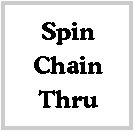HERE’S THE NEXT FIVE PROPOSITIONS FROM THE SYNOD OF THE EUCHARIST.
Having raised the question of "Sunday assemblies awaiting a priest" in Prop 10, the fathers go on to discuss vocations in Proposition 11.
They basicallly ask for a greater push for vocations–particularly by parish priests serving as recruiters.
They also reaffirm the discipline of priestly celibacy for the Latin Church and ask that the reasons for it to be explained to the faithful. Hopefully, B16 will go into some detail about that in his apostolic exhortation, because there is an annoying tendency in ecclesiastical documents for requests to be made for the reasons for something to be explained to the faithful but then (as here) there is NO ENUMERATION OF THOSE REASONS, meaning that the explainer just has to make his best guess at figuring out what the Church has in mind (and on some subjects it’s not even clear what the Church has in mind).
It would be so much nicer if, whenever an ecclesiastical document asks that the reasons for something be explained to the faithful if it then went on to say "And here’s what those reasons are."
I’ve seen Pre-16 offer his personal thoughts on the reasons for clerical celibacy before. Hopefully he’ll give us some official reasons in his apostolic exhortation.
One other note in this proposition is a push to have "a more equitable distribution of the clergy," which means moving priests around from high-vocation centers to low-vocation centers. In principle, that’s fine as long as it doesn’t serve to mask the PROBLEMS in a particular area that are CAUSING it to have a lack of vocations (e.g., heterodox vocations officers who drive away the best candidates for the priesthood or regional seminaries whose faculties are consciously trying to eliminate orthodox seminarians).
Proposition 12 continues the vocations theme by suggesting practical steps the fathers of the Synod hope will be taken to get more vocations. This is pretty standard stuff (priests giving their vocation stories, setting up vocation centers, having Eucharistic adoration for vocations).
A couple of items, while logical, have been unfortunately handled in recent years.
One is the recommendation of focusing on altar servers as potential vocations. The problem here is that you can’t just tell altar servers that they need to consider a vocation to the priesthood because MANY of the altar servers are INCAPABLE of becoming priests since the previous pontificate decided to allow girls into the altar server pool.
Had that not been the case it would be possible to make a stronger push for altar servers to consider becoming priests, but now it’s harder to deliver that message because of the extra nuances that have to be built into its delivery to the target group.
This could be solved, of course, by ceasing to have female altar servers, but I don’t see that happening. (Imagine the outcry. B16 has bigger problems he needs to spend his public capital on.)
Another suggestion that will be complicated in the light of recent events is the suggestion that priests mentor young people (meaning, young boys) and steer them towards vocations.
The problem here (at least in this country) is that in light of the recent priestly sexual abuse scandal parents in many places are frequently going to want to MINIMIZE CONTACT between their sons and parish priests. The less time priests get to spend with boys, the less they can encourage them to consider becoming priests.
Proposition 13 deals with the order of the sacraments of initiation (baptism, confirmation, the Eucharist). This section suggests an in-depth study of Confirmation to more clearly bring out its role and connection to the Eucharist, which would be good since the three sacraments of initiation share a common orientation that is often not understood.
The big news here, though, is that the fathers suggest that the Latin right RECONSIDER THE AGE AT WHICH CONFIRMATION IS TO BE ADMINISTERED.
YEE-HAW!!! This is something that is long overdue.
For a start, the age of confirmation in the United States is A TOTAL MESS. Basically, the U.S. bishops years ago got permission out of the Vatican to basically let each bishop set his own age for confirmation in his diocese (within certain limits). This is AN ENORMOUS PROBLEM and A TRAGIC MISTAKE in a society as mobile as ours, because it is GUARANTEED TO RESULT IN CHILDREN FALLING THROUGH THE CRACKS AND NOT GETTING CONFIRMED as families move from diocese to diocese.
If you’re in a diocese where the confirmation age is 16 and you’ve got a 15-year old kid and then you move to a diocese where the age of confirmation is 7, guess what! Your kid is past the age of confirmation in this diocese and will either have to go to special classes or be shoehorned in with a bunch of 7 year olds.
Conversely, if you have a kid who’s been confirmed at 7 and then you move to an age-16 diocese then when he’s 16 he’s going to sit out what all the other kids his age in the parish are doing because he’s already been confirmed.
We’ve really got to get a single age for confirmation in the United States, and any Church-wide revisiting of the age of confirmation is a good thing in that it could result in that.
The re-examination may have even more dramatic results than that, though, because what they’re talking about (at a minimum) is whether we should mandate that kids get confirmed BEFORE they have First Communion and (at a maximum) whether they should be confirmed immediatley after baptism (as done in many of the Eastern Catholic churches).
Either of these would be an improvement, as they would both restore the ideal order of reception of the sacraments of initiation (baptism, confirmation, Eucharist, not baptism, Eucharist, confirmation).
They would also get around a lot of the nuttiness that goes on in high school confirmation classes (which are also frequently a friction point between teens and parents if the kid is going through a rebellious stage and isn’t sure if he wants to be confirmed).
My preference on this question tends to be Eastern, so I’d love it if they had confirmation administered immediately after baptism, the way it was typically done in the early Church. But I’d be happy if they just mandated that confirmation be administered before First Communion.
(Note that the preceding commentary may tell you more about my concerns about the celebration of confirmation than it does about the Eucharist, though the question of the sequencing of confirmation relative to the Eucharist is a Eucharist-related question.)
Proposition 14 basically calls for renewed Christian education in parishes, focusing on the Eucharist and the Catechism of the Catholic Church and other recent Magisterial teachings.
It also stresses that seminarians "must understand as well as possible the meaning of each liturgical norm."
Proposition 15 basically calls on the family and the parish to be involved in preparing kids for sacramental initiation.
 Wow, I was just saying in one of the comboxes how I hoped that His Holiness B16 would put the smackdown on secularized American Catholic universities by yanking their "Catholic" designation.
Wow, I was just saying in one of the comboxes how I hoped that His Holiness B16 would put the smackdown on secularized American Catholic universities by yanking their "Catholic" designation.



